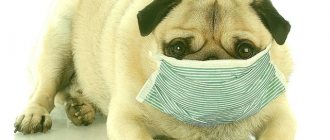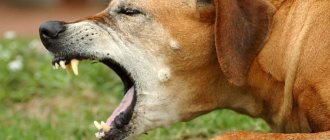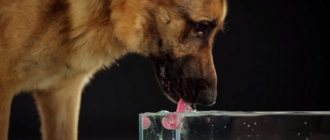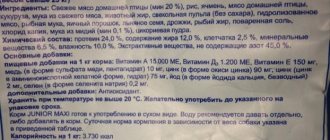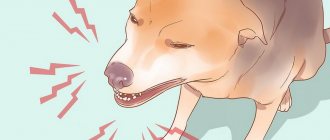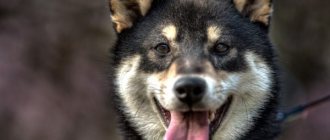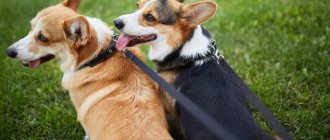There can be many reasons why a dog wheezes, and they will not always be negative, but this condition of the pet should still not be ignored. The type of wheezing will help determine the disease itself, its degree and causes. Depending on the source of the disease, it can be the bronchi, trachea and lungs, which produce wet and dry wheezing.
Main causes of difficulty breathing
Let's consider the main causes of difficulty breathing, which are most often encountered in the practice of veterinarians around the world. Of course, in the first place are the common “colds”, which sometimes also affect dogs.
In the simplest cases, it’s all about rhinitis:
- The mucous membrane of the nose and other parts of the upper respiratory tract first becomes inflamed due to the activity of pathogenic and conditionally pathogenic bacterial microflora.
- Inflammation leads to the development of swelling.
- The respiratory passages narrow, which is why the dog can no longer breathe deeply, sniffles and groans.
But this is one of the easiest and relatively harmless reasons. It happens that simple rhinitis goes down, resulting in inflammation of the lower parts of the respiratory system. This is how bronchitis or even pneumonia often occurs.
Breed predisposition
We will look at more “specific” cases. This includes breed predisposition. If a person has ever encountered the following breeds, then he knows how their typical representatives sniff and grunt:
- Bulldogs, especially English ones.
- Some mastiffs.
- Pugs, etc.
All these animals are united by the same circumstance: they are all brachycephalic, i.e. dogs with short and flattened muzzles. It just so happens that it is very problematic to deceive nature and physics, and therefore in such animals the structure of the respiratory system is far from anatomically correct. And therefore the same bulldogs will hiss, grunt and grunt all the time. And the older such a pet is, the more clearly all this will manifest itself. Nothing can be done about it.
Owners of such dogs must comply with the following rules:
- There is no need to walk with your pet if the weather is too hot or too cold.
- The room where such a “pig” is kept must always be maintained at optimal temperature and humidity. In the south, by the way, air conditioning would be a good idea.
- Bulldogs, in principle, are not fans of long walks, and therefore there is no need to walk with them for three hours.
Chest trauma
It happens that the cause of difficulty breathing is a chest injury. Therefore, in cases where the dog was hit by a vehicle, got into a fight, or simply returned home covered in blood and with other signs of injury, special attention should be paid to the presence/absence of the following symptoms:
- Wheezing.
- Prolonged and “metallic” cough.
- Pain on palpation of the chest.
- Discharge of foamy exudate or even blood from the mouth and respiratory passages.
The injuries themselves vary and the causes of difficulty breathing also vary. But nevertheless, the general “mechanics” of such phenomena can almost always be identified:
- Severe bruise of the muscles responsible for contracting the chest during breathing. If they are knocked off and hurt, the dog will not be able to breathe normally and will try to take deep breaths, since they cause pain when injured.
- Fractured or cracked ribs . Moreover, any inhalation can cause serious pain to the dog, and therefore breathing becomes shallow, wheezing and very frequent.
- Lung contusion. In this case, the animal also cannot breathe normally, and pulmonary edema may develop. When inhaling and exhaling, wheezing, hissing, and grunting are heard.
- Due to the fracture of the ribs, their fragments tore the pleura or damaged the lungs themselves. At the same time, any inhalation or exhalation causes severe pain to the pet. Breathing becomes hoarse, hoarse and shallow, rapid, blood and/or bloody foam is released from the mouth and respiratory openings.
Important! If you suspect a chest injury, you should immediately call a veterinarian!
Asthma
As in the case of humans, asthma in animals causes many serious problems for the latter. This disease is characterized by a sudden, spastic narrowing of the bronchi, as a result of which normal breathing becomes impossible. The cause of the disease still remains not fully understood, but it is known for sure that allergies almost always contribute to its occurrence. There are also predisposed breeds, which include almost all varieties of poodles and lapdogs.
What could the disease be?
There are different types of bronchitis in dogs. They differ not only in signs, but also in treatment features, so they must be determined by the veterinarian who examines and diagnoses the animal. These types of bronchitis include:
- Hemorrhagic . It is accompanied by hemorrhages in the bronchial mucosa, so the animal suffers from hemoptysis even outside of coughing attacks. This is the most dangerous form of the disease;
- Fibrinous . The main feature is that cough sputum contains the protein fibrin, which has a gray-yellow tint;
- Catarrhal . An additional sign indicating catarrhal bronchitis is profuse mucous discharge when coughing;
- Putrid . Already from the name it becomes clear that this form of bronchitis is accompanied by a sharp putrefactive odor that occurs against the background of a developing infection;
- Purulent . A characteristic feature of this form of bronchitis is sputum, which contains purulent inclusions.
Additional symptoms: how to tell how serious an attack is
Additional symptoms help determine the severity of the attack and the danger of the underlying causes of the pathology. If you carefully analyze them, you can obtain a lot of valuable information that helps both in the diagnostic process and in treatment.
Wheezing and grunting sounds when breathing
One of the most common symptoms is wheezing and grunting sounds when breathing.
They can occur in the following cases:
- Bronchitis and pneumonia.
- This phenomenon often occurs when there are larvae of parasitic nematodes in the lungs.
- Allergies accompanied by symptoms of swelling.
- Asthma attacks.
- This happens with severe chest injuries, accompanied by the development of hemothorax (blood entering the chest).
The dog is coughing and choking
If your dog is coughing and choking, this may indicate:
- Presence of foreign bodies in the respiratory tract.
- Severe helminthic infestations, when parasites can enter the bronchi and pulmonary alveoli.
- Severe cases of bronchitis and pneumonia.
- Tracheal collapse.
- The presence of tumors in the bronchi or the pulmonary parenchyma itself.
The dog suffocates while sleeping
If a dog is choking while sleeping, you can suspect the following pathologies:
- Firstly, this often indicates helminthic pathologies. The dog is strangled either by parasite larvae in the lungs or by adult worms. The latter is possible due to relaxation of the gastrointestinal tract muscles during sleep and in case of high intensity of infection.
- Secondly, it may be a sign of asthma.
- Thirdly, tracheal collapse often manifests itself.
If your dog's tongue turns blue
In situations where a dog’s tongue turns blue, the veterinarian should be called immediately, regardless of the time of day! This symptom is extremely dangerous:
- This indicates the presence of a foreign body in the respiratory tract.
- This is how the terminal stages of tracheal collapse manifest themselves.
- Particularly severe asthma attacks can lead to blueness.
- Hypoxia of this degree develops with advanced tumors, provided that the neoplasm has begun to collapse directly in the respiratory tract.
Thus, blue discoloration of the tongue and visible mucous membranes always indicates a severe degree of hypoxia, which is directly dangerous to the life of the pet. Veterinary assistance must be provided immediately!
Periodic attacks of suffocation
If a dog experiences periodic attacks of suffocation, this may indicate the following pathologies:
- This often indicates asthma.
- This happens with allergies.
- It is possible that this symptom indicates helminthic infestations.
- In many cases, this is how the first and second degrees of tracheal collapse manifest themselves.
- It is possible that a tumor has “settled” in the organs of the dog’s respiratory system and is slowly growing.
- If the dog is overly impulsive and sensitive, then such signs may indicate the psycho-emotional nature of the attacks.
The dog is wheezing, what should the owner do?
From all of the above, it becomes clear that if a dog wheezes, it is better to immediately take the animal to an appointment with a veterinarian. Remember, there is no way you can diagnose the disease yourself, because this requires special equipment and qualifications.
If the dog’s wheezing has become more and more audible, and its behavior is increasingly reminiscent of a seizure, the owner needs to put aside panic and do the following:
- Open all the windows, thereby providing the dog with a large amount of oxygen.
- Do not touch your pet if he looks like he has found the most comfortable position for himself. Moreover, you should not grab the animal by the chest or neck.
- If you have an oxygen tank at home, don't be afraid to use it.
- If the dog is in relatively normal condition, examine its mouth - you may notice a foreign object in the throat. However, you should be as careful as possible - an excited animal may well bite you.
During the above procedures, try to think about when exactly your dog started wheezing, whether the wheezing was wet or dry, whether it was accompanied by other symptoms, and whether you gave your pet any medications. All this information can significantly speed up the diagnostic process, and in especially severe cases, even save the dog’s life.
First aid for a dog with signs of suffocation: what can be done before the veterinarian arrives
The owner can provide first aid to a dog with signs of suffocation:
- The dog is immediately given complete rest; it must be isolated from loud noises, small children, etc.
- The air in the room where the sick animal is located should not be excessively dry or humid. We advise you to immediately ventilate and refresh the room.
- If there is a suspicion of asthma, or if your pet suffers from periodic attacks of suffocation of unknown etiology, it is advisable to carry out high-quality wet cleaning of the premises every day. But we do not recommend using chlorine or other “chemicals”, since chemicals can contribute to the development of new attacks.
- If the pet's condition gradually returns to normal, he can be given lukewarm, sweetened water. Just give the drink little by little: as soon as the dog choke, everything will start again. In addition, the animal can choke, choke and die.
Important! Under no circumstances should you hold or otherwise restrain an animal during an attack! If a dog develops severe enough hypoxia, it may well not recognize its owner, and therefore become dangerous.
Severe bites and other injuries in such situations are completely commonplace. To prevent troubles, we can only advise placing a sick pet in a room with a minimum amount of furniture and open corners. Even if the dog “loses control” during an attack, he will not receive serious injuries.
Treatment for wheezing in dogs
Treatment for your dog depends on what disease your veterinarian has diagnosed. Below is a basic list of methods for treating pathologies that are accompanied by wheezing, coughing and difficulty breathing.
| Disease | Therapy |
| Kennel cough | Your veterinarian may recommend the following medications:
|
| Canine flu | Treatment is carried out:
|
| Asthma | Treatment options:
|
| Emphysema | Treatment methods:
|
| Allergy | Possible treatment options include:
|
| Infectious diseases of the respiratory tract | Treatment includes:
|
| Weight loss | Types of treatment:
The rest of the appointments will depend on the exact diagnosis and concomitant diseases that are identified during the diagnosis. |
| Heartworms | First, drugs are used that stabilize breathing and the functioning of the cardiovascular system - to normalize the animal’s condition. And then they use arsenic-based drugs to kill parasites. |
Diagnosis of respiratory organs
As a rule, diagnostics of the respiratory system is carried out according to the following scenario:
- Detailed external examination of the pet , paying attention, first of all, to the condition of all its visible mucous membranes and fur, as well as to the characteristics of breathing (even, intermittent, deep or superficial, etc.).
- Auscultation (listening) of the chest . It is so easy to identify moist rales, “seething” and gurgling in the lungs, and other important symptoms.
- Percussion of the chest (tapping). An experienced specialist can identify changes and shifts in the boundaries of internal organs (lungs and heart), and suggest the presence of fluid or air in the cavity.
How is the diagnosis carried out?
To establish a diagnosis, the doctor needs to examine the dog and listen to its breathing, to make sure there is a presence or absence of noise in the lungs. The color of the gums will also be assessed, as this indicates whether oxygen is being delivered effectively to the organs and whether there is anemia (the number of red blood cells in the blood will be low).
Additionally, a blood test will be performed and the following may be prescribed:
- X-ray;
- Ultrasound of the lungs and heart.
Until breathing improves, the dog may be hospitalized. Treatment will be prescribed depending on the symptoms and diagnosis.
Important! Your pet may be given oxygen to quickly make breathing easier.
Treatment in clinical and home conditions: features and recommendations
Firstly, you must immediately decide on one important nuance: in case of more or less serious diseases of the respiratory system, we would strongly advise against resorting to “self-medication”. So in cases where the question arises about which conditions for therapy to choose, i.e. treatment in clinical and home conditions, you should always prefer a professional clinic. There is very little you can do at home:
- In mild cases, expectorants, anti-inflammatory drugs, antibiotics and other antimicrobial drugs, anthelmintics, etc. are given.
- Sometimes the owner himself can give an asthmatic dog inhalation, but nothing more.
Clinical treatment directly depends on the type of pathology, and we have already written about many aspects above:
- In oncology, if there is at least some possibility of removing the tumor, surgery is required. Otherwise, intensive chemotherapy and radiotherapy.
- For asthma, antispasmodics, antihistamines and other specific medications are used.
- The most difficult thing is with tracheal collapse. In the first two stages, you can still get by with antitussive medications and anti-inflammatory corticosteroids, but as the disease progresses, they all become completely meaningless. The only solution is an expensive operation, during which the veterinarian will install implants, strengthening the animal’s “native” trachea.
- In case of “harmless” parasitic infestations (more precisely, in advanced cases), it is sometimes necessary to resort to surgery. There are cases when a dog’s lungs are literally “exhausted” by numerous parasite larvae, and only a timely operation can save the life (and even partially the health) of the dog.
- For pneumonia and bronchitis, the pet is prescribed a course of powerful broad-spectrum antibiotics, droppers, anti-inflammatory corticosteroids, etc. are indicated.
Finally, I would like to warn breeders that timely contact with a veterinarian plays a huge role.
If the dog can no longer breathe and instead of lungs he has a couple of “bags” of pus, then even the best clinic cannot help him. In cases where the owner turned to specialists on time, there is every chance of getting by with little bloodshed. This way the dog will be healthier, and the funds for his treatment will be spent an order of magnitude less.
Forms of bronchitis: acute and chronic
Along the way, there are two more forms of bronchitis in dogs - acute and chronic . Each of them has its own characteristics, which are important to consider when diagnosing and treating the disease:
- Spicy . Most often, the acute form of bronchitis occurs against the background of a viral infection. Inflammation develops quickly, appetite worsens. Characteristic signs include difficulty breathing and oxygen deprivation (hypoxia). There may be a slight increase in body temperature.
- Chronic . It differs in that the disease develops gradually and is replaced by periods of remission. The dog has periodic coughing attacks. Breathing is difficult, wheezing is possible. As with the acute form, the animal has no appetite, so the dog rapidly loses weight.
Proper animal care
The first step is to provide warmth and rest to a dog suffering from bronchitis. To do this, provide your pet with a comfortable and dry place to sleep in a heated room. The veterinarian gives recommendations on nutrition individually, but in any case you will need easily digestible food with multivitamins. If natural food is used, it should be soft and warm. Walking in bad weather should be kept to a minimum. All treatment prescribed by a specialist must be strictly followed. It is impossible to interrupt therapy, even if the symptoms of bronchitis disappear.
By following these simple recommendations, you will ensure a quick recovery for your dog!
Associated symptoms of diseases
Increased breathing is often accompanied by the following pathological symptoms:
- shiver;
- anxiety;
- lethargy;
- cough, wheezing;
- body temperature rises;
- the color of the tongue changes;
- abnormal behavior;
- profuse drooling;
- thirst.
Trembling and restlessness
The male gets worried and trembles when he senses that a bitch is leaking nearby. Testosterone surges are accompanied by tachypnea.
Tremor, as a symptom, occurs in cardiac pathologies, infectious and non-infectious diseases, and in stressful situations. Post-traumatic pain, labor, severe fear causes anxiety, trembling, tachypnea.
Lethargy and inactivity
The dog is breathing heavily, looks lethargic, and inactive for the following reasons:
- heart muscle diseases;
- endocrine pathologies: diabetes mellitus, adrenal hyperfunction;
- diseases of the digestive system: flatulence, poisoning;
- ascites;
- oncology.
Similar symptoms occur with contagious diseases.
Cough and wheezing
Cough in a dog
Pathologies of the respiratory system are accompanied by a cough, which produces sputum containing pus and blood. Another reason is heart disease. The affected organ puts pressure on the bronchi, causing a reflex forced exhalation.
In bronchial asthma, cough is accompanied by wheezing. When a dog swallows a foreign object, it tries to get rid of it by coughing. In all cases, the animal breathes not through its nose, but through its mouth. To saturate your lungs with oxygen, you have to breathe very often.
Temperature increase
The inflammatory process manifests itself in intoxication and hyperthermia. When body temperature rises, respiratory movements increase automatically.
Changing tongue color
Anemia, otherwise anemia is accompanied by a drop in the number of red blood cells or hemoglobin concentration. The gums and tongue turn white. To saturate the blood with oxygen, you have to breathe often. When the tissues swell, the tongue becomes red.
Subsequently, dark spots appear on it, they turn black. The purple or blue color of the tongue is caused by blood saturated with carbon dioxide. The symptom indicates cardiac, pulmonary failure, poisoning.
Chow Chows and some breeds have a purple tongue from birth. Therefore, the owner does not have to worry if the pet looks healthy.
Strange behavior
Epilepsy in dogs
Due to the special structure of the larynx, reverse sneezing syndrome occurs in Spitz during periods of stress or illness. The dog behaves strangely, the sneezing sounds like a cough, and the respiratory rate increases.
Another anomaly is convulsions turning into epileptic paroxysms. Before an attack, the pet fusses, tries to hide, drools, and sways.
Increased salivation
Abundant salivation occurs in the following cases:
- poisoning;
- stress;
- gingivitis;
- the dog swallowed an inedible object
- The pet had an epileptic seizure.
Hypersalivation interferes with breathing, which becomes frequent, shallow, and intermittent.
Extreme thirst
Thirst occurs when the kidneys are unable to remove toxins or metabolic wastes from the body that are poisoning the body. Water dilutes toxic substances. The volume of urine increases and the urge to urinate becomes more frequent. This condition is called diabetes.
The kidneys are working overload. Fluid accumulates and swelling occurs. Water takes up part of the usable area of the lungs. To ensure ventilation of the lungs, you have to breathe more often. With ascites, water that has accumulated in the abdominal cavity puts pressure on the pet's lungs. In hot weather, the dog drinks a lot to cool down through the evaporation of fluid from the mucous membranes.
Rapid breathing and protruding tongue
Everyone knows the natural reasons for such breathing - this is a recent walk, a fast run, experiencing strong emotions or overheating on a hot day.
But at the same time, the reason why a dog breathes with its tongue hanging out may be pathological processes:
- injuries or inflammatory processes in the respiratory system;
- problems of the cardiovascular and endocrine systems;
- lack of normal innervation of any respiratory organ;
- allergic reaction.
If rapid breathing does not stop, it is necessary to urgently arrange a visit to the doctor. If it is impossible to visit the clinic at this time, first aid measures must be provided.
To do this, provide the dog with oxygen by opening the windows, and remove the collar if it is fastened around the pet’s neck. Try to remove all the factors that lead the dog to stress, calm it down with talking and stroking. Moisten the hair in the head area with clean water and give the dog a drink.
Wheezing associated with tracheal collapse or bronchitis
In dogs, the trachea consists of C-shaped cartilage, which is covered by a flexible membrane. In some small breed dogs, this membrane can become loose or loose over time, and when the dog inhales, the trachea can collapse in on itself, narrowing the airway and making it difficult for the dog to breathe.
Tracheal collapse is common in Pugs, Maltese, Shih Tzus, Lhasa Apsos and other small short-nosed breeds. Anxiety or exercise can make this type of wheezing worse.
Chronic bronchitis can also cause scarring of the airways, which can make the bronchi less flexible, leading to persistent wheezing and coughing.
